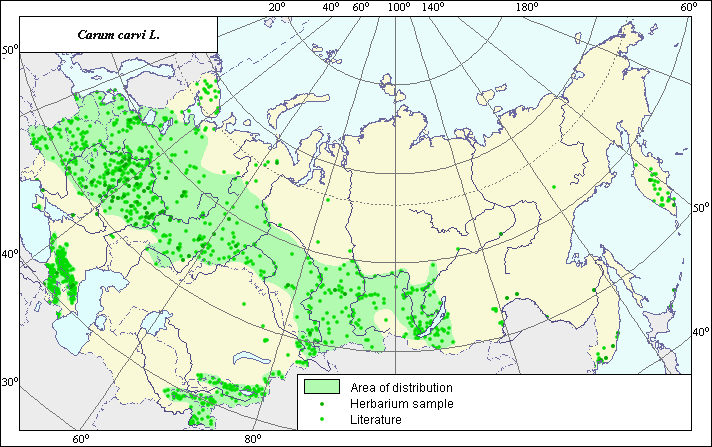Relatives
The area of Carum carvi L. (Caraway)
 Object description Download GIS-layers
Object description Download GIS-layers
Authors:
The expert-botanist - T.N. Smekalova, the GIS-expert - G.V. Talovina.Date of creation:
24.12.2003.Scale:
1:20 000 000.Accuracy of a map:
Map is based on data from herbarium specimens and on maps having the following scale: 1:10 000 000 - 1:80 000 000.The projection:
"Alber's Equal Area Conic for Russia", 9, 1001, 7, 100, 0, 44, 68, 0, 0.Basic contents:
Map is a vector file consisting of polygon and points. Points represent locations of species; area of possible distribution of species is represented by polygon.Accuracy of classifier:
Light-colored points are locations referenced in literature sources. Dark-colored points are locations of species that were reported from herbarium samples (All-Russian Vavilov Institute of Plant Industry, Moscow State University, Voronezh State University, Voronezh National Reservation, Rostov State University, Kalmykia State University, Uljanovsk State Pedagogical University, Russian Academy of Sciences). Polygon is based on generalized information from literature sources, herbarium specimens, political boundaries and ecological description. Literature used included: Grossgheim, (1967); Shishkin, (1950); Cherepanov, (1995); Tsvelev, (2000); Hulten, (1986); Moosel, (1965); Ramenskaja, (1983); Malyshev & Peshkova,(1979); Tolmachev, (1983).Method of map production:
Published literature was reviewed, including Atlases, monographs and papers. Occurrence data were obtained from herbarium specimens, floras, monographs and papers. Data were then compiled through scanning and geo-referencing to develop a composite vector map. The biologist together with the GIS specialist drew a new plant distribution area based on compiled data.Reference citations:
Cherepanov S.K. 1988. Plantae Vasculares Rossicae et Civitatum Collimitanearum (in limics USSR olim)[List of Vascular Plants of Russia]. St. Petersburg: Mir I Semia. 990 pp. (In Russian)Far Eastern Branch, Russian Academy of Science (BPI DVO) [VLA], Vladivostok, Russia.
Grossgheim, A.A. 1967. Flora of Caucasia. Leningrad: Nauka. V. 7: appendix. (In Russian)
Hulten E., Fries M. 1986. Atlas of north European vascular plants north of the Tropic of Cancer. Konigstein. V.1-3: 1172.
Kalmykia State University Herbarium, Elista, Russia.
Malyshev, L.I. & G.A. Peshkova, ed. 1979. Flora of the Central Siberia. Novosibirsk: Nauka. V.2: 678.
Moscow State University, Moscow, Russia.
Mosel H. 1965. Comparative Chorology of the Flora of Central Europe. Jena. 583 p.
N.I. Vavilov All-Russian Institute of Plant Industry [WIR], St. Petersburg, Russia.
N.I. Vavilov Institute, Herbarium Department, 1992. Information retrieval system: wild-growing relatives of cultural plants of Russia. STC Informregistr 0229905883, St. Petersburg, Russia.
Ramenskaya M.L. 1983. Manual of the vascular plants of Murmansk district and Karelia. Moscow-Leningrad: Nauka. 95-97 pp. (In Russian)
Rostov State University [RWBG], Rostov On Don, Russia.
Shishkin, B.K., ed. 1950. Flora USSR. Moscow-Leningrad: Publishing House of the USSR Academy of Sciences. V.16: 386. (In Russian)
Tolmachev A.I., ed. 1983. Atlas of areas and resources of medicinal plants of the USSR. Moscow. 120-121, 313 pp. (In Russian)
Tsvelev N.N. 2000. Manual of the vascular plants of North-West Russia (Leningrad, Pskov and Novgorod district). St. Petersburg: Publishing House of SPHFA. 511 pp. (In Russian)
Uljanovsk State Pedagogical University, Uljanovsk, Russia.
Voronezh National Reserve [VGZ], Voronzeh, Russia.
Voronezh State University, Voronzeh, Russia.

